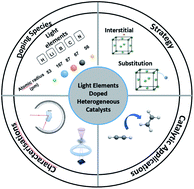Interstitial and substitutional light elements in transition metals for heterogeneous catalysis
Abstract
The addition of foreign element dopants to monometallic nanoparticle catalysts is of great importance in industrial applications. Both substitutional and interstitial doping of pure metallic phases can give profound effects such as altering electronic and transport properties, lattice parameters, phase transitions, and consequently various physicochemical properties. For transition metal catalysts, this often leads to changes in catalytic activity and selectivity. This article provides an overview of the recent developments regarding the catalytic properties and characterisation of such systems. In particular, the structure–activity relationship for a number of important chemical reactions is summarised and the future prospects of this area are also explored.

- This article is part of the themed collection: Chemical Science Recent Perspective articles


 Please wait while we load your content...
Please wait while we load your content...